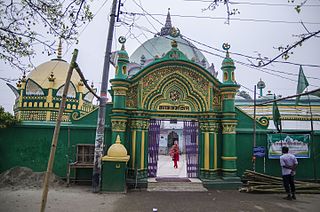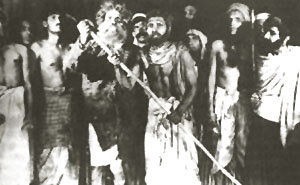
The University of Chittagong is a public research university located in Hathazari, Chattogram, Bangladesh. It was established on 18 August 1966. It is one of the oldest universities in Bangladesh. Its 2,312.32 acres (935.76 ha) campus is the largest among universities in Bangladesh. It is also known for providing quality education to its students. It is one of the four autonomous by the act universities of Bangladesh.

The Bangla Academy is the official regulatory body of the Bengali language in Bangladesh. It is an autonomous institution funded by the Government of Bangladesh that fosters the Bengali language, literature and culture, works to develop and implement national language policy and conducts original research in Bengali. Established in 1955, it is located in the Burdwan House in Shahbagh, Dhaka, within the grounds of the University of Dhaka and Suhrawardy Udyan. The Bangla Academy hosts the annual Ekushey Book Fair.

Manikganj is a district in central Bangladesh and part of the Dhaka Division. Established in 1845, it was originally a subdivision of Faridpur District. In 1956, it was included in Dhaka District for administrative purposes. In 1984, Manikganj was declared a full district.

Zainul Abedin, also known as Shilpacharya was a Bangladeshi painter. He became well known in 1944 through his series of paintings depicting some of the great famines in Bengal during its British colonial period. After the Partition of Indian subcontinent he moved to East Pakistan. In 1948, he helped to establish the Institute of Arts and Crafts at the University of Dhaka. The Indian Express has described him as a legendary Bangladeshi painter and activist. Like many of his contemporaries, his paintings on the Bengal famine of 1943 are viewed as his most characteristic works. His homeland honored him with the title "Shilpacharya" "Great teacher of the arts" for his artistic and visionary attributes. He was the pioneer of the modern art movement that took place in Bangladesh and was rightly considered by Syed Manzoorul Islam as the founding father of Bangladeshi modern arts, soon after Bangladesh earned the status of an independent republic.

Sirajganj District is a district in the North Bengal region of Bangladesh, located in the Rajshahi Division. It is an economically important district of Bangladesh. Sirajganj district is the 25th largest district by area and 9th largest district by population in Bangladesh. It is known as the gateway to North Bengal.

Nitya Gopal Kundu was a Bangladeshi artist, sculptor and entrepreneur. Kundu played an important role during the liberation war of Bangladesh in 1971. He founded the furniture company Otobi.

Bengali theatre primarily refers to theatre performed in the Bengali language. Bengali theatre is produced mainly in West Bengal, and in Bangladesh. The term may also refer to some Hindi theatres which are accepted by the Bengali people.

Ekushey Padak is the second highest civilian award in Bangladesh, introduced in memory of the martyrs of the Bengali Language Movement of 1952. The award is given to recognize contributions in a number of fields, including culture, education, and economics. The Ministry of Cultural Affairs administers the award.

Meril Prothom Alo Awards or Prothom Alo Awards is an annual Bangladeshi awards ceremony honouring cinematic achievements in Bangladeshi Film Industry. The awards are divided into two components, Viewers' Choice and Critics' Choice. The awards were first presented in 1998 and since then the awards are given every year at the Bangabandhu International Conference Center (BICC).
Mustapha Khalid Palash is a Bangladeshi architect. He is considered one of the leading contemporary architects of Bangladesh. He is also an artist, multi instrumentalist-singer and painter. He is the editor of quarterly DOT: Journal on Art & Architecture, one of the prominent architecture magazines of Bangladesh.

The Samdani Art Foundation is a private art foundation founded in 2011 in Dhaka, Bangladesh that aims to increase artistic engagement between the art and architecture of Bangladesh and the rest of the world. It is best known for producing the bi-annual Dhaka Art Summit, which is the highest daily visited contemporary art exhibition in the world, welcoming over 477,000 visitors in its fifth edition in February 2020. It completed its sixth edition in 2023. The foundation produces education programmes and exhibitions across the year in collaboration with Bangladeshi and international institutions and is one of the most active art institutions in South Asia.
Talim Hossain was a Bangladeshi poet. He was the founder of Nazrul Academy in Dhaka. He was the editor of the literary magazine Mahe Nao in the 1960s. He was awarded Ekushey Padak in 1982 by the Government of Bangladesh for his contribution to Bengali literature.

The Nazrul Institute is Bangladesh's national institute, established in February 1985. Its headquarters are located in Kabi Bhaban in Dhanmondi, Dhaka, Bangladesh. It fulfills a number of roles; promoting the literary work of the poet Kazi Nazrul Islam, recognising excellence in literature research by conferring awards, and public engagement.
Kazi Sabyasachi was a Bengali elocutionist. He was the eldest surviving son of one of the most prolific Bengali poets of the 20th century Kazi Nazrul Islam.
Photography in Bangladesh began with the creation of Bangladesh through the liberation war of 1971, against Pakistan. At the time, inevitably, war time photography was of utmost prominence, which has also largely helped document history. Since the war, photography and photojournalism have come to include and cover a large array of subjects including landscape, politics, wildlife, fashion etc.

Ila Majumder was a Bangladeshi classical vocalist. Bangladesh Shilpakala Academy awarded her for the special contribution in the field of culture. She was the spouse of the classical musician of Barin Mazumder.












